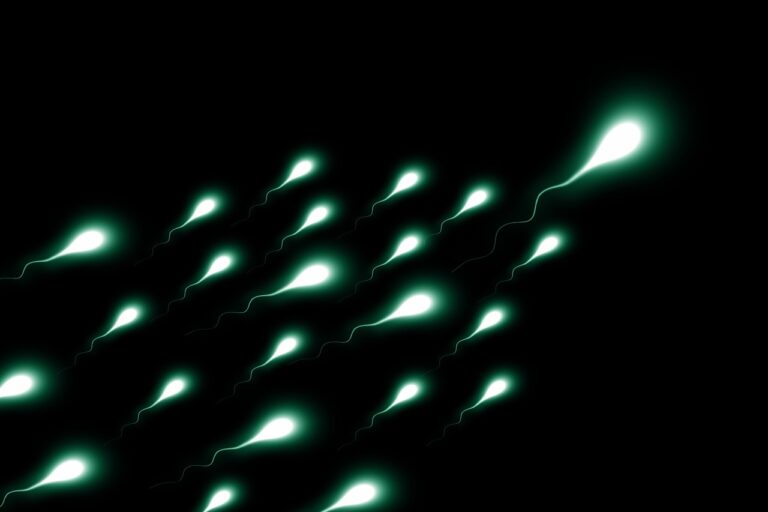Each time a man ejaculates, he releases millions of sperm. These tiny swimmers are designed to reach and fertilize an egg cell, and they have a long tail to help them move, lots of mitochondria for energy, and genetic information to pass on.
Sperm can survive for several days inside a woman’s body in the fluid of her reproductive tract, which provides all the nutrients they need. This is why the fertile window is up to five days before ovulation, and it’s so hard to pinpoint the exact day of ovulation.
Factors Affecting Sperm Survival
It’s important to understand that sperm can live outside of the body for a little while, but their longevity depends on the environment in which they find themselves. They can survive for a few hours to up to five days following sexual activity, but only if they’re in the right place – This part of the material is taken from the website Sex Relax. For example, they can’t survive for more than a few seconds on a dry surface like a piece of cloth or a towel. If ejaculated into a tub of water, they can last longer because they thrive in warm, wet environments. But the chances of a pregnancy occurring in that scenario are extremely low.
The cervical mucus that surrounds a woman’s fallopian tubes can also be crucial for sperm survival. When a woman is at her most fertile, this fluid usually changes from opaque to clear and offers a welcoming environment for sperm as they travel towards the fallopian tubes. It also provides a layer of protection that can help sperm survive for up to five days. This is because the cervix contains cervical ‘crypts,’ small channels off the cervical canal that serve as temporary storage areas for sperm. These crypts cleverly release the sperm over time, helping to create the ‘fertile window’ that allows sperm to reach and fertilize an egg.
Outside of these ‘fertile’ conditions, sperm are typically dead within minutes of being exposed to a dry surface. In fact, Web MD explains that when semen is collected and analysed straight away in a laboratory, about half of all the sperm will be dead. But if sperm were to be released into a sterile, dark container at body temperature, they could survive for up to seven days.
Cervical Mucus
As women prepare for ovulation, the body produces cervical mucus that is designed to be sperm-friendly. During the “wet days,” which are the few days before and after ovulation, this cervical mucus takes on a clear, stretchy consistency similar to raw egg whites, which is why it’s sometimes referred to as EWCM (egg white cervical mucus). This type of cervical mucus is very slippery and easy for sperm to move through. It also protects sperm from the hostile acidic vaginal environment and provides them with nutrients to support motility. It even acts as a natural filter to ensure only the best and healthiest sperm are allowed to reach an egg, further increasing the chances of conception.
The composition and consistency of cervical mucus changes throughout the menstrual cycle, influenced by a woman’s hormone levels. Before ovulation, higher levels of the estrogen hormone estradiol in the body causes the cervical mucus to change in texture and appearance. The jelly-like fluid becomes thicker, and its water composition changes as well.
This change in the quality of cervical mucus reflects a woman’s fertility potential. Tracking the changes in cervical mucus can help women identify their fertile window, and thus, plan and time intercourse to maximize their chances of conceiving. In addition, a healthy lifestyle and diet can improve cervical mucus’s quality, further enhancing fertility.
pH Levels
When a man ejaculates, roughly 100 million sperms are released into the cervical fluid. A small number of sperms survive this initial assault and are able to move towards the fallopian tubes, where they can wait for an egg to be released from the ovaries. This waiting period lasts for three to five days, depending on where a woman is in her menstrual cycle and the conditions in her vagina.
The pH levels in a woman’s vagina are affected by both hormones and the environment in which she lives. For example, if a woman has an acidic vagina, the sperm that are produced may not have enough energy to penetrate the vaginal canal and enter the uterus or fallopian tubes.
However, during sex, the vaginal fluid’s pH rises temporarily. This creates an alkaline environment that sperm prefer, which helps them survive and move towards the ovaries more easily. Changing the way you use the bathroom and avoiding harsh soaps can also help keep your vagina’s pH levels balanced.
Another factor in sperm survival is the consistency of cervical mucus. During ovulation, changes in hormones alter the texture of this mucus, making it more resistant to drying out than it normally is. It also thins instead of maintaining its typical opaque texture, creating just the right environment to protect sperm and facilitate movement.
Sexual Activity Frequency
The frequency of sexual activity can significantly impact a woman’s fertility. While it is possible to conceive without sex, it is also more likely to happen with regular sexual activity. For this reason, it’s important to understand how long sperm can survive after being ejaculated, especially as it can have an effect on the likelihood of conception.
Sperm live for three to five days inside the female reproductive tract, where they are protected by cervical mucus and cervical ‘crypts’. They are also preserved for decades when semen is frozen. However, outside the body, sperm die quickly if they dry out. Once they’ve landed on cold, dry surfaces such as skin or fabric, they typically die within thirty minutes. Those that reach the vagina can survive longer, although only about 1% of sperm get to the uterus and ultimately fertilise an egg.
Sperm may also be able to live longer when ejaculated into a condom, which offers the right conditions for survival. A recent study showed that sperm ejaculated into a condom survived for hours, whereas those ejaculated onto fabric or skin only lived for a few minutes. Knowing how long sperm can live in different environments can help couples trying to conceive, particularly when they know when the woman is due to ovulate. Then, they can focus on having sex during the most fertile window, which is the few days leading up to ovulation.
See Also:


